Bjørnøya's history and cultural remainsBy Kristin Prestvold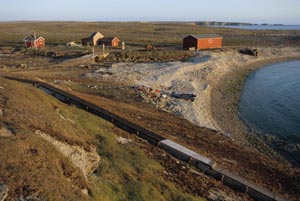

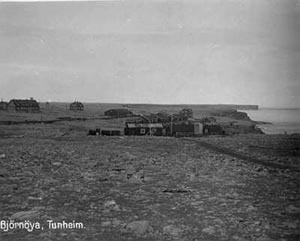
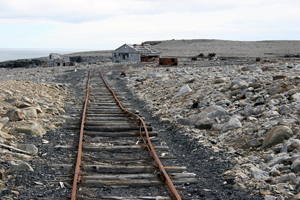

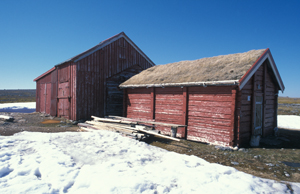
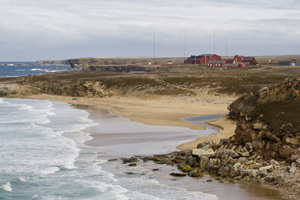
The first documented visit to Bjørnøya was two Dutch ships in 1596. William Barentsz navigated one of them. This marks the beginning of humans taking advantage of the island’s natural resources. For several hundred years hunting for marine mammals and seabirds was the most important goal of these northern expeditions. There are many cultural remains on Bjørnøya, and they date from different historical eras and stem from different nations. The oldest cultural remains are skeletal remains at the slaughtering sites for walrus. Over the course of 200 years, the walrus population was hunted down to almost nothing. The first hunters were Englishmen who annually killed around 900 animals between 1605 and 1607. In those days, Bjørnøya was the first stop on the way to the main part of the Svalbard archipelago, where the English hunted whales and carried out mapping of the waters around the archipelago, including mapping of safe ports and good places for whaling. In the early 1600s the English had only just begun whaling, and in reality had no experience of it whatsoever. Bjørnøya’s walrus was a good substitute before whaling was learned properly and Spitsbergen and its surrounding islands took over completely as the only stop for ships and crew. From 1603 until 1612 Bjørnøya was visited by 11 hunting expeditions, and around 3000 walrus were slaughtered. Russian Pomors came to Bjørnøya to hunt in the latter part of the 1700s. They hunted walrus, polar bears, seals, foxes and birds. They also collected eggs and feathers. The Pomors have left graves and remains of sites and Russian orthodox crosses at St. Sebastian, in the west of Kvalrossfjæra in Nordhamna. There are also remains of sites in Russehamna, in the south of the island. The best preserved ones (St. Sebastian) are subjected to strong erosion by waves. The site is being monitored. In 1818 and in the years that followed the walrus population was once again slaughtered. In 1818 alone 900 animals were killed by Englishmen. The rumour of walrus reached Norway, and in 1822-1823 an expedition from Hammerfest spent the winter here. The cabin Hammerfesthytta was constructed from logs in Herwighamna; it is still standing. The cabin was added to in 1865-1866 by Sivert Tobiesen, and it became known as Tobiesen’s house. This is the only building that has been preserved, and it represents the first phase of Norwegian hunting, when the expeditions were large and walrus were the main target. The period of overwintering hunting ended shortly after. A land-based station for whaling was built by Morten Andreas Ingebrigtsen in 1905-1908 in Kvalrossbukta, in the south of the island. Old photographs show that there once used to be more buildings here. Today, a well preserved group of sites and a steam boiler remain. A German called Theodor Lerner (casually known as the “Count of Fog”) attempted to excavate coal by Kvalrossbukta in 1898, with no success. Led by the company Bjørnøen AS, a new attempt at extracting galena in Gruben and Blyhatten, north of Sørhamna, also failed. Most of Bjørnøya’s cultural remains can be found in Tunheim, in the north-eastern corner of the island. Here Bjørnøen AS excavated and shipped out about 115 000 tonnes of coal in the period between 1916 and 1925. There were 25 houses and up to 182 people spent the winter here. In 1919 a radio station was opened, and a meteorological station was built in 1923. However, Tunheim was evacuated and ruined by the allies during World War II. A whole “town” of ruins can today be found on the edge of the sea. The only building that has been preserved is the storage for explosives, which is now used as a cabin for recreation by the crew at the meteorological station. Tunheim is an example of a belief in progress that was apparent in the first decades of the 1900s. Many enterprises were built on unsteady foundations, and many of them were closed down after a few years of trial runs. Tunheim, today in ruins, has an important historical reference value as a memorial to optimism and perseverance. There are many more cultural remains on Bjørnøya beyond those that are mentioned here. In 1947 a new radio meteorological station was built in Herwighamna close to Tobiesen’s house. Today it is run by a crew of nine people, which is changed twice a year. The station consists of about 20 buildings in total, in an area of approximately 150 000 m2. Current activitiesThe only year-round activity carried out on Bjørnøya today is that of the meteorological station. Other than that, annual scientific research on Bjørnøya consists of monitoring seabirds. In the summer of 2006 the complete bird life of the island was mapped. Scientists from other nations (English, French, Swedish etc.) also work here from time to time. Fishing vessels can often be found in the waters around the south and the east of the island, where they find lee to reload or refuel. Bjørnøya is not a popular tourist destination, although many ships pass on their way to or from Spitsbergen. Each year Bjørnøya has between 200 and 300 visitors, and most of these alight in Herwighamna, a few in Kvalrossbukta. In a bid to protect birdlife from people, three areas with a ban on traffic (for limited periods in summer) were established within the nature reserve in 2002 (shown with red dotted lines in the map). The largest of these areas includes the bird cliffs in the south between Kapp Harry and Kapp Malmgren, and extends 1 nautical mile from the shore. Within this area it is only permitted to travel in boats that are smaller than 40 feet in length. In an emergency this area can also be used as a port. The second area in the south is Kapp Heer and Måkeholmen. It is not allowed to be in this area between 1 April and 31 August. The third area is around the lakes Laksvatnet and Lomvatnet, in the north-eastern part of the island. To protect the great northern diver, it is not allowed to enter this area between 15 June and 31 August. Updated March 2015 |
The Cruise Handbook is also available in book formHard cover with numerous pictures - 249 pages - NOK 249.00 Norwegian Polar Institute |
 Norsk
Norsk